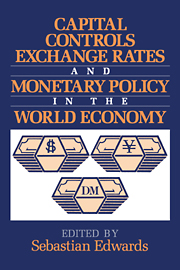Book contents
- Frontmatter
- Contents
- List of contributors
- Introduction
- Part I Monetary policy and stabilization in open economies
- Part II Capital mobility and macroeconomic policy in Europe
- Part III Capital controls and macroeconomic policy in the Asia-Pacific region
- 8 Capital movements, real asset speculation, and macroeconomic adjustment in Korea
- 9 The determinants of capital controls and their effects on trade balance during the period of capital market liberalization in Japan
- 10 Capital mobility and economic policy
- 11 Monetary and exchange rate policies 1973–1991: the Australian and New Zealand experience
- Part IV Capital mobility and exchange rates in Latin America
- Index
10 - Capital mobility and economic policy
Published online by Cambridge University Press: 16 October 2009
- Frontmatter
- Contents
- List of contributors
- Introduction
- Part I Monetary policy and stabilization in open economies
- Part II Capital mobility and macroeconomic policy in Europe
- Part III Capital controls and macroeconomic policy in the Asia-Pacific region
- 8 Capital movements, real asset speculation, and macroeconomic adjustment in Korea
- 9 The determinants of capital controls and their effects on trade balance during the period of capital market liberalization in Japan
- 10 Capital mobility and economic policy
- 11 Monetary and exchange rate policies 1973–1991: the Australian and New Zealand experience
- Part IV Capital mobility and exchange rates in Latin America
- Index
Summary
Various countries are currently engaged in reform programs designed to increase the role of market forces in guiding resource allocation. The incentives behind these programs, and their scope, vary but are related to the view that, as economies develop, the complexity of economic activity quickly outstrips the administrative ability of government decision makers.
Korea is an important example of an economy in transition in that the government intends over time to allow residents to participate freely in international capital markets. Such a policy initiative has far-reaching implications for other important economic institutions and policies. In fact, it is probably not an exaggeration to claim that all the ways in which the government interacts with the economy will be affected by this single development.
One of the standard results from open economy theoretical models is that the degree of capital mobility is an important determinant of the effects of monetary and fiscal policies. In this chapter we argue that an equally important consideration for policy makers is that capital mobility increases the speed with which the private sector reacts to policy decisions. A related concern is that, once under way, the pace of liberalization of capital markets is difficult to control and even difficult to measure. measure. Thus, during the transition, policy makers need information about the degree of integration of international and domestic capital markets.
- Type
- Chapter
- Information
- Publisher: Cambridge University PressPrint publication year: 1995
- 1
- Cited by

